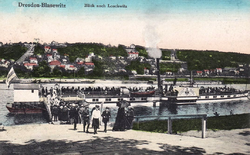Königstein (ship, 1892)
|
as Count Moltke in Dresden − Blasewitz
|
||||||||||||||||||||
|
||||||||||||||||||||
|
||||||||||||||||||||
|
||||||||||||||||||||
|
||||||||||||||||||||
The paddle steamer Königstein was built in the Blasewitz shipyard in 1891 . The ship was under the name of Count Moltke with the hull number 29 to set keel . In 1919 it was named Lobositz and in 1949 the third ship was named Königstein .
The time after commissioning until 1945
After being launched on July 17, 1892, the ship was put into service as a smooth deck steamer . It operated for the Saxon-Bohemian Steamship Company (SBDG) until 1923 . After the cessation of business operations, the ship sailed for the Saxon-Bohemian Steamship Company (SBDA), which was newly founded in 1923 . The white painting of the ships, which was customary from 1926, earned it the name White Fleet .
On May 25, 1919, like all ships bearing the name of a monarch or a monarchy, it was renamed and given the name Lobositz , named after the place Lobositz .
The ship and engine were overhauled in 1907/08.
In the years 1919-1922 the ship was due to difficult economic conditions after the end of World War launched . A sale to Oberweser Dampfschiffahrt for 115,000 marks failed, as did the attempt to sell the ship to Sweden.
In the winter of 1926/27 a wheelhouse was built and the ship received a manual control winch. In the course of the work, electrical lighting was also installed. The generator was driven by a steam turbine from Kuhnert-Turbowerke AG, based in Meissen . In the winter of 1927/28 a steam control machine , which was supplied by the German works with the construction number 5559, was installed. In the winter of 1928/29 the ship was painted white.
On April 28, 1928 the Lobositz collided with the barge of a tug of the Czech ČPSL (Československou plavební akciovou společností labskou) near Mittelgrund . The left wheel arch was damaged.
In 1936, on the occasion of the company's 100th anniversary, the ship was rebuilt and given the appearance of Queen Maria . After it was dismantled, it was used again as a Lobo seat from 1937 .
In the summer of 1943 the Lobositz, like all steamers, was given camouflage. At the end of the Second World War , the ship was in the port of Prossen .
The time after 1945
On August 26, 1945 the Lobositz was confiscated by the Czechoslovak Republic and towed to Děčín . Here it was incorporated into the stock of ČSPLO , but was not used. In 1948 the ship was returned and on 1 February 1947 the name VEB Schiffahrtsgesellschaft Saxony in public property transferred over to SBDA. From 1950 to 1957 it belonged to the VEB Deutsche Schiffahrts- und Umschlagszentrale (DSU). After its dissolution, the VEB Fahrgastschiffahrt und Reparaturwerft Dresden was established in 1957 and from 1967 the VEB Fahrgastschiffahrt Dresden .
After the return to Dresden, the ship and engine were overhauled in the Laubegaster shipyard. The wooden blades on the side wheels were replaced by iron blades. On June 1, 1949, it was returned to service under the name of Königstein .
In 1963/1964, instead of the steam turbine, a diesel engine was installed to generate energy and a new lighting system was installed.
In 1966/67 the ship and the engine were overhauled and a new navigating bridge was installed.
In July 1969, the ship was taken out of service and parked as a reserve ship in Neustädter Hafen . In autumn 1969, the ship's bottom was repaired in the Laubegaster shipyard.
In 1971 the ship was finally decommissioned. Various fittings and machine parts were dismantled and stored in the port's workshop. On May 4, 1972, the Königstein was towed to the shipyard in Aken to be scrapped . Here the ship was dismantled into two parts and the boiler and engine were scrapped.
The Eisleben consumer cooperative bought the hull. This was transported in May 1973 with heavy goods vehicles to Seeburg near Eisleben on the north shore of the Süßen See and set down on a concrete foundation built for this purpose. Here it was expanded to become a ship's restaurant and on July 7, 1973, it was named Seeperle .
In 1992 the Königstein became the seventh ship to celebrate 100 years. Even if it is no longer part of the fleet, it is an anniversary.
The steam engine
The steam engine was an oscillating low-pressure two-cylinder twin steam engine with injection condensation and an output of 110 hp. It was built by the Saxon Steamship and Mechanical Engineering Institute of the Austrian Northwest Steamship Company in Dresden . The two-flame tube suitcase boiler with the serial no. 571 supplied the machine with steam.
Captains of the ship
- Carl August Richter 1892
- Friedrich Eduard Kunze 1893–1898
- Carl Friedrich Klemm 1899–1901
- Gustav Adolf Thieme 1902–1914
- Ernst Hugo Riedel 1915–1918
See also
literature
- Erlpeter Kulturblatt for Pirna, issue 34 / April 2004
- Shipping calendar for the Elbe area from 1892 to 1914
- Shipping calendar for the Elbe area and the Märkische Wasserstrassen from 1915 to 1920
Web links
- Passenger steamer Königstein
- Passenger steamer Königstein - data sheet
- List of paddle steamers of the Saxon-Bohemian Steamship Company
Coordinates: 51 ° 29 ′ 39.7 " N , 11 ° 41 ′ 30.4" E



